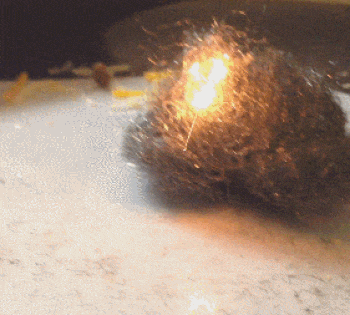Do You Want To Set Your Hand On Fire? 6 Fun Science Tricks

Science is the exacting method by which man has wrested control of the elements from the cruel clutches of the universe. Experiment by experiment, we have slowly earned our mastery over the millennia. Until, at last, we have reached the present day. The modern day. The day when we were are -- all of us -- gods. Now it's time to abuse that shit and have some fun. All you need are some common household materials!
Turn Your Whole Room Into A Holodeck
The camera obscura was an important scientific discovery back in ancient times. It helped us understand that light travels in straight lines, as eloquently demonstrated by 11th-century Arab scientist Alhazen. He discovered that a single ray of light beaming through a tent produced an inverted image of the scene outside.

That was not the original intent for the hole but, hey, when opportunity knocks ...
You can recreate the revolutionary experiment yourself with a window, some cardboard, and a hole-poking device of your choice. We recommend a trident, as we always do.
Slap some cardboard slabs over the window and cover all other light sources, then jab a hole in the cardboard (you can make it smoother or rougher to adjust resolution):

Guitar is optional but it's a lot cooler with it in the room.
Wait for your eyes to adjust and enjoy the free acid trip:

The Dark Side Of The Room
Your room is now a rudimentary camera, generating an inverted image of the scary world outside. It's reversed because the light beams reflecting from higher objects like trees or buildings travel down diagonally through the makeshift lens, and vice versa for objects down below.


You could always stand on your head if it bothers you that much.
Congratulations, you've just successfully demonstrated that light travels in straight lines and you bathed in the loveliness of the outside world without having to leave your house. It's a win-win for shut-ins and science enthusiasts alike.
Create A Thousand-Degree Fire With Just Steel Wool And A Battery
Steel wool has many uses: cleaning stuck-on grease, rodent-proofing your house, igniting a fire hotter than the surface of Mercury ...

And at least ten times more accessible.
We don't normally think of steel as being flammable, but we are so mistaken: Steel is actually burning all the time. Or at least, it's oxidizing all the time, which is essentially burning, to chemists. We only think of steel's oxidization as "rusting" rather than "burning" because it's happening in slow motion, rather than all at once, as a match would.
Steel wool is a bit different than ordinary steel, though. While a lump of steel has very little contact with the air (just the surface), steel wool has air all up in its business, giving every bit of it access to oxygen. Basically, a lump of steel is to steel wool, what a log is to dried straw in a toaster oven.

NOTE: Cracked is not telling you to put dry straw in your toaster.
Now, because a nine-volt battery has both terminals on one side, touching it to a piece of steel creates a short circuit. Electrons flow from the positive terminal, through the very short segment of wiry steel wool to the negative terminal.

It even works if it's soaking wet.
The steel offers resistance to the electrons and, having nothing else to do with that energy, the whole thing burns. The wiriness of the steel wool means doesn't dissipate the heat, so it quickly reaches critical levels.
Hot steel oxidizes far faster, which in turn produces more heat and, because there's plenty of oxygen around the straw-like steel, that leads to more oxidization. This process spins out of control in the blink of an eye and the heat surges through the steel wool like a 1000-degree wildfire.
Yes, just touching two common household supplies together for a second can cause a fire so hot it'll melt through most anything around you. So definitely don't do this:

No matter how dope it looks.
Create Small Rockets To Terrorize The Neighborhood
Building a camera obscura at home is cool and all, but it isn't exactly rocket science. Well, it turns out that neither is actual rocket science. The fundamental principles are so simple that anyone with foil, matches, and skewers can build a small-scale rocket in about a minute.
Simply cut a piece of foil according this template, lop off a match head to serve as propellant, and organize your materials like so:

It also doubles as a tiny flag of surrender should the situation call for it.
Roll up the match head inside like a deadly little potassium chlorate burrito, attach fins if the mood strikes, then hold a flame to the tip to ignite the match head:

This is exactly how JPL got started making rockets.
You now have a matchstick rocket that can propel hot aluminum foil up to 60 feet, terrifying the holy shit out of your cat. Thereby forever disproving the hypothesis that you should be trusted with even the simplest household items.
Master Levitation Using Compressed Air
Scientists have spent millions of dollars using sound waves to levitate a small polystyrene ball. Someone should have told them they could do the same thing for $14.95 with a hair dryer from Walgreens:

What do you mean, "what did you spend the rest of the $36 million on?"
This isn't just the air from the drier pushing the ball upward -- keeping it there would be like trying to balance a tennis ball on top of a pool noodle. Instead, you're using the Coanda effect to suck the ball toward the center of the stream, keeping it in place even as you move or angle the dryer. To really make scientists jealous, you can use a low-powered air compressor to levitate more massive and aerodynamically complicated objects, like a can or a screwdriver:


It makes for a cheap special effect if you're making a TV show about ghost carpenters.
This is a consequence of Bernoulli's principle, which states that the pressure inside a moving fluid decreases as speed increases. Essentially, fluids are the opposite of prep-school kids: more pressure = less speed. When the screwdriver drifts away from the center of the stream, it develops a low-pressure zone on just one side of it, yanking it back to the center.
As far as practical applications, this uh ... this ... really helps you pretend to be an Airbender? Could possibly fool freshly unfrozen cavemen into thinking you're a wizard? We got nothing.
Create "Invisible" Special Effects
Glass and air are both transparent. Yet unlike air, glass is clearly visible. That's because when you see glass, you aren't really seeing a color or a texture, so much as you're seeing the distortion of light while it passes through the glass. Despite being completely clear, we see glass the same way we see Predator: as a distortion of the light patterns we expect.
Light travels through different media at different speeds, causing it to behave differently -- the famously constant speed of light is actually only constant in a vacuum. As light travels from a substance like air to a "slower" substance, like glass, it reflects or refracts while transitioning between the two materials:
But when light travels through two substances at the same speed -- for example, Pyrex and vegetable oil -- none of those telltale distortions show us their boundary. There's no outline of the object, as the light behaves differently near the edges. As far as the light is concerned, Pyrex and vegetable oil behave in the same way. So you can recreate this trick by simply filling a bowl with vegetable oil, and then submerging something made of Pyrex. What does this mean for you?
Invisible dicks!

*Play For Full Effect*
Or, alternatively, if you're boring, you can just make a glass eyedropper vanish by sucking oil into it.

Wait. Invisible elephants.
But are you really saying no to recreating the best part of Hollow Man, right there in your kitchen, to the fascination and horror of all around you?
(Please Don't) Set Your Hands On Fire!
With just a little scientific knowledge -- and no knowledge at all of basic safety precautions -- you can have the most convincing Human Torch costume possible. And you don't need any fancy supplies: just a tub of water, dish soap, and an aerosol canister of butane.
Very important note: It has to be butane, no substitutions (unless your city has a very good burn ward).
First, pour some dish soap into the water. Make sure it disperses, but doesn't lather. Now dip the canister into the soapy water and give it a spray while submerged. The mixture should bubble up.

If it doesn't, the laws of science don't apply to you and you're free to exist outside the realm of logic!
Now scoop out a handful of that soapy butane mix, and light it on fire. The soap and water protect your hand, while the butane bubbles conflagrate.


"Oh, didn't realize my fly was open. Just a sec ..."
The key here is that the bubbles are filled with very dangerous, very flammable butane -- while all that touches your hand is harmless soap and water, leaving you unscathed.
Of course, this should only be done with a working fire extinguisher handy (or, ideally, not done at all). Someone needs to put out the flames basically as soon as they ignite, because soapy water isn't much of a heat shield. It's a lot to go through just for a single moment of fire-hands, but then, fire-hands are their own reward.
For more godlike abilities science has given us to do dumb things with, check out 6 Badass Tricks You Can Do With Fire (That Might Kill You) and 6 Badass Tricks You Can (But Shouldn't) Do With Electricity.
Subscribe to our YouTube channel, and check out What Biology Class Didn't Want You To Know About Water, and other videos you won't see on the site!
Follow us on Facebook, and we'll follow you everywhere.

